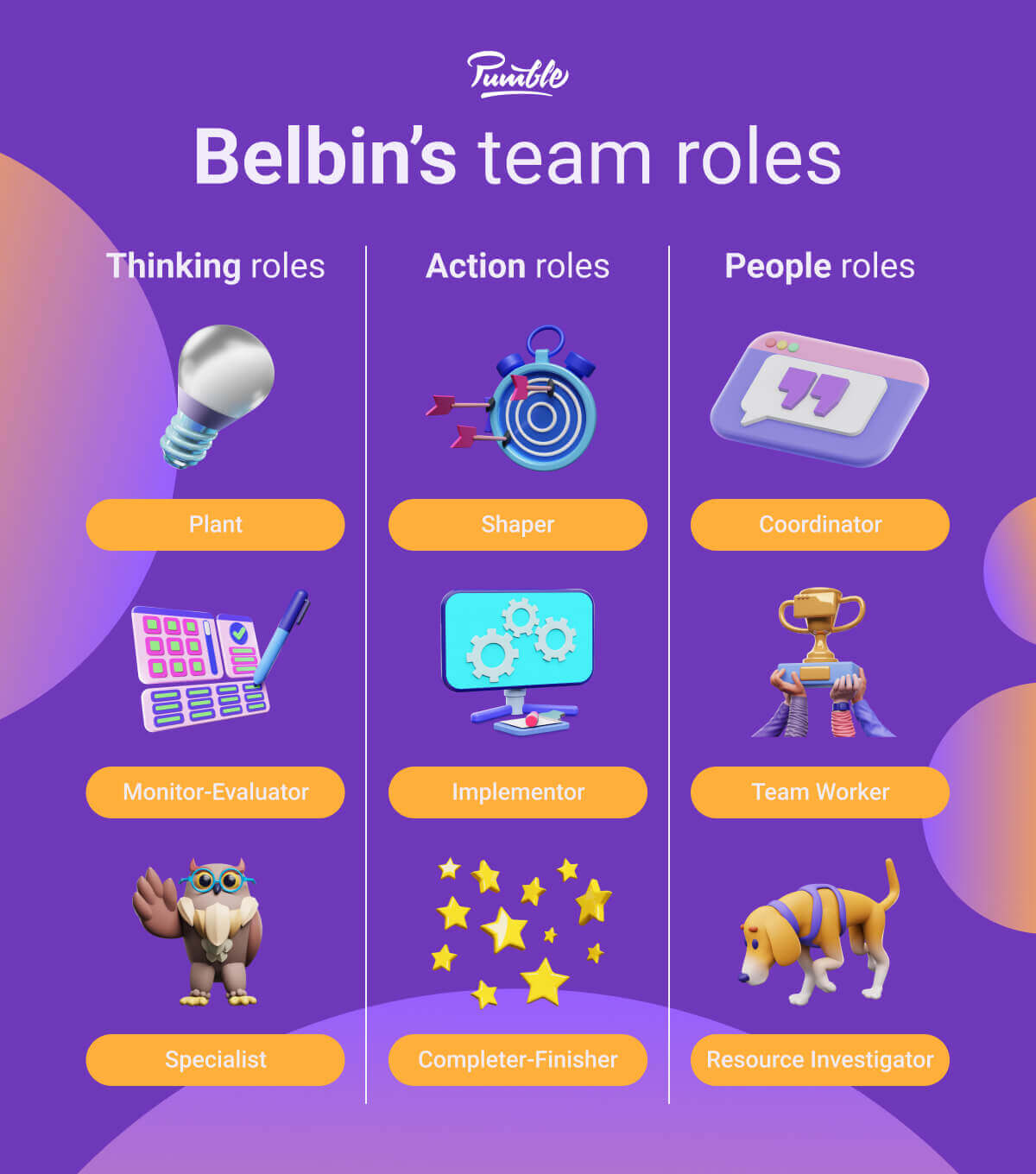In every professional work team, each member performs a primary function as defined by their job title. But, as we have already established, there’s more to team collaboration than all individuals simply performing their primary duties. Aside from their primary functions, all members of collaborative teams assume additional team roles, whether knowingly or not.
This article will:
- Identify various team roles,
- Describe their distinctive qualities and purposes, and
- Highlight the importance of achieving the right balance of team roles among collaborators.
- Team roles are tasks that team members perform to self-manage the team’s activities.
- According to English researcher and management consultant Raymond Meredith Belbin, the most performant teams are those with the optimal distribution of 9 team roles divided into 3 groups.
- The 3 categories are thinking roles, action roles, and people roles.
- Understanding the individual roles in a group helps assess the overall team structure and identify any weaknesses or pain points.
Team roles definition
Team roles are tasks and functions that team members perform to self-manage the team’s activities. They define how team members should interact with one another to facilitate the progress of the team.
From the second half of the 20th century, researchers have begun looking into the impact of individual psychological characteristics of employees on the success of the group as a whole. One of their goals has been differentiating employee strengths to nurture better collaboration.
These inquiries have yielded several different models, theories, and definitions of team roles, but none have been as impactful and influential as the work of English researcher and management consultant Raymond Meredith Belbin.
Belbin’s teachings, now most commonly known as the “Belbin Team Inventory”, have been rooted in a 10-year research on the performance of a large number of teams. Belbin found that the driver of the highest performances is the right balance of different behaviors — i.e. team roles. He has highlighted the importance of understanding and strategically leveraging these roles for effective team performance.
According to Belbin, a team role is “a tendency to behave, contribute, and interrelate with others in a particular way.”
🎓 PUMBLE PRO TIP
To better understand the shared characteristics of high-performing teams and how to best implement them, read our article on the subject:
Assurer la productivité de l'équipe — utilisez Pumble
Belbin’s team roles
Based on his research, Belbin has identified 9 distinct clusters of behavior (the initial number was eight, expanded to nine in a later revision of his research). He translated those clusters into 9 team roles divided into 3 groups.

According to Belbin, the most performant teams are those with the optimal distribution of 9 team roles across their ranks. He has emphasized the significance of aligning individuals with roles that emphasize their strengths to contribute to a harmonious team dynamic.
Each role has certain characteristics that are beneficial to the operations of the team. Furthermore, each role possesses certain drawbacks.
The 3 categories that Belbin recognized all depict certain characteristics based on which the team members’ roles are divided:
- Thinking roles — This group of roles provides the innovative, analytical, and expert aspects of the team’s operations,
- Action roles — This group of roles in a business team is in charge of the operational, actionable, and task-based aspects of the team’s inner workings, and
- People roles — Team members from this category are largely concerned with various aspects and dynamics of interpersonal relationships within the team and beyond.
#1 Plant
People who assume the role of a plant are creative thinkers capable of generating new ideas and coming up with outside-the-box solutions.
They are commonly introverted and inclined towards independent work and tend to have difficulties dealing with criticism. They can also be forgetful and absent-minded.
The name of the role stems from the fact that Belbin’s collaborators insisted that he “plants” one such participant into every research group.
| Biggest strengths | Allowable weakness |
|---|---|
| Innovative thinker, generates unconventional ideas | Tendency to disregard incidentals, difficulty in communicating ideas to others |
Example: In a brainstorming session for a new marketing campaign, Brian comes up with a unique and creative idea to use augmented reality, suggesting an innovative way to engage the target audience.
Organiser des séances de brainstorming sur Pumble
#2 Monitor-Evaluator
Team members in the role of monitor-evaluator are logical and impartial thinkers who are good at analyzing and assessing the ideas of others.
They are detail-oriented and objective, analytical, and capable of viewing the broader picture. That’s why they can easily account for all options and accurately weigh the pros and cons of any situation. They often may seem cold and detached, overly critical, and they tend to struggle with decision-making.
| Biggest strengths | Allowable weakness |
|---|---|
| Analyzes information objectively, offers strategic insights | Tends to be reactionary, rarely initiates action or inspires others |
Example: Maria objectively analyzes the potential risks and returns of each investment project proposal, providing a thorough assessment to guide the decision-making process.
🎓 PUMBLE PRO TIP
To not come across as overly critical, monitor-evaluators should learn how to properly share feedback for better results. Read our tips on this matter in our article:
Demander et donner un feedback sur Pumble
#3 Specialist
Specialists are single-mindedly dedicated to their professional area, providing in-depth expertise for the team.
They are committed to applying their specialized knowledge and are passionate about expanding it. This commitment often prevents them from contributing to or even showing interest in anything outside of their immediate scope.
They tend to be preoccupied with little details and can overwhelm others with them. The role of specialist was later added to Belbin’s initial 8 group roles, as the original research did not require any specialized knowledge.
| Biggest strengths | Allowable weakness |
|---|---|
| Provides in-depth knowledge and skills | Limited scope of contributions, over-focus on technicalities |
Example: David, a programming expert, contributes specialized knowledge in coding and debugging a new application, playing a vital role in the successful development of the software.
#4 Shaper
Shapers are task-oriented team members who continuously challenge others to perform.
They are highly driven, motivated, and capable of pushing others to perform and improve. They possess a can-do attitude and are focused on achieving the objectives placed before them. They tend to thrive in high-pressure situations and take pride in overcoming obstacles.
| Biggest strengths | Allowable weakness |
|---|---|
| Provides direction and drives for results | Tends to be confrontational, their drive can make them seem insensitive |
Example: When faced with a tight deadline, Emma energizes the team, challenges members to step up their efforts, and drives them to their end goal through intense and focused effort.
#5 Implementer
Implementers are planners and strategists who take the ideas of the team and turn them into actionable steps.
They are efficient and meticulous, highly reliable, and disciplined. They are committed to the work of the team and tend to take on the tasks that others avoid. On the other hand, they tend to be slow to adapt to changing circumstances.
| Biggest strengths | Allowable weakness |
|---|---|
| Turns ideas into action, plans, and organizes | Often inflexible and unwilling to change their plans |
Example: Mark takes charge of turning a project plan into action, organizing resources, assigning tasks, and ensuring that each step is implemented effectively.
Organisez des séances de planification sur Pumble
🎓 PUMBLE PRO TIP
Adapting to change is a big problem in the workplace, which is why it is important how changes are communicated. To learn more about this topic, read our blog post:
#6 Completer-Finisher
Team members assuming this role are detail-oriented perfectionists who detect and correct errors until the results of the collective effort are blemish-free.
They are highly conscientious and primarily focused on standards and deadlines. Their perfectionism can be overwhelming to their teammates.
| Biggest strengths | Allowable weakness |
|---|---|
| Ensures precision, identifies errors, and meets deadlines | Prone to worrying excessively, have difficulties delegating tasks |
Example: Chris meticulously reviews a crucial document and corrects errors, making sure that the final version is flawless before submission.
#7 Coordinator
Most commonly (but not necessarily), the team role of the coordinator is assumed by a formal team leader. Coordinators are team members who always have a birds-eye view of the shared work and make sure that everyone is focused on the objectives.
They are good at understanding the strengths and weaknesses of other team members and delegate work fairly and effectively. In essence, they serve as team guides.
| Biggest strengths | Allowable weakness |
|---|---|
| Guides the team, clarifies goals | May be seen as over-calculated and scheming, can be prone to delegating their own share of work |
Example: Alex takes charge of organizing the company retreat, assigns tasks to team members based on their strengths, and ensures that everyone is on schedule.
🎓 PUMBLE PRO TIP
Learn how to become a better leader through effective communication styles that will leave a positive lasting impact on your colleagues.
#8 Team Worker
Team workers prioritize the harmony and the interests of the team and serve as the “glue” that brings people together.
They are the negotiators on the team — flexible, cooperative, great at listening and resolving conflict. They are also willing to identify and handle unpopular tasks that help the collective work move along.
| Biggest strengths | Allowable weakness |
|---|---|
| Promotes harmony, ensures cooperation, provides support | Avoids confrontation at all costs, prone to indecision |
Example: Claire mediates between two team members who have differing opinions, finding common ground through a collaborative approach to resolve the conflict.
🎓 PUMBLE PRO TIP
Read on about helpful tips on how to enhance productivity and problem solving within your team.
#9 Resource Investigator
This type of team member is the networker and mingler of the group.
They are positive and outgoing, excellent at developing relationships, and inquisitive and knowledgeable about the world outside the group. They pursue contacts and opportunities that can benefit the team, researching the work of others for ideas and directions for the group.
| Biggest strengths | Allowable weakness |
|---|---|
| Explores opportunities, communicates effectively, and networks | Can be overly optimistic, tend to lose enthusiasm in the later stages of the shared work |
Example: Sarah contacts industry experts and attends networking events to identify potential partners and gather valuable insights.
How do I know my team role?
To determine one’s behavior in a team setting, Belbin has developed a “Self-perception inventory”, a questionnaire designed to identify one’s preferred team role.
The results of this questionnaire can be combined with “observer assessments” (i.e. how others perceive you) for a more objective result.
It is important to state that Belbin’s self-assessment inventory is not a personality test and it does not determine one’s personality type.
Although there is a common correlation between certain roles in group dynamics and certain personality types from other methodologies (such as the Myers-Briggs Type Indicator, for example), the questionnaire does not focus as much on the individual as it does on how the individual interacts with other team members.
Another important thing to note is that the team roles should not be taken as a strict doctrine but more as an indicator of the team’s balance, in terms of lacking an important team role or having too many team members with the same preferred role.
Belbin’s proprietary questionnaires can be obtained online and in the author’s books.
What if my team has fewer than 9 people?
So, if there are 9 team roles, does that mean that a team should have at least 9 members?
The answer is no.
Even Belbin considers 4 team members the optimal number, with more than that constituting a group rather than a team.
On smaller teams, certain team members can assume multiple complementary team roles. For instance, a coordinator can also be an implementer.
Additionally, depending on the unique circumstances of the team’s work, some team roles may be less important or entirely redundant. Therefore, it is important to properly assess the nature of the team’s work and its operational priorities to determine which team roles are necessary, and which are perhaps less important.
🎓 PUMBLE PRO TIP
Team roles can also depend on the type of team you are a part of. Discover the defining criteria and where your team falls through the examples in our article.
Why are team roles important?
If we all instinctively assume team roles towards which we are naturally inclined, then why is it important to understand what roles team members perform?
The answer is in the balance.
As Belbin’s research has shown, balance is one of the key elements of good collaboration. The most performative teams turned out to be those that strike the right balance between different team roles to address the variety of professional scenarios.
Understanding the individual roles in a group helps us assess the overall team structure and identify any weaknesses or pain points. The key objective is to achieve the right distribution of team roles, where all relevant functions are covered and where different team members do not assume the same role.
However, depending on the role, the duplication of roles may not necessarily be a bad thing. For instance, there is nothing wrong with having more than one team worker, but problems may arise if two or more people wish to assume the role of a coordinator.
Additionally, the self-assessment inventory (and other accompanying questionnaires) provide insight into the distribution of working styles and help us make adjustments to address any disbalance.
Enable efficiency through united collaboration with Pumble
Effective communication and collaboration are pivotal for successful teamwork, and integrating Pumble – a communication and collaboration platform – can significantly enhance these aspects.
By leveraging Pumble’s features, teams can:
- Streamline communication,
- Share insights, and
- Foster seamless collaboration.
It not only aligns with the principles of optimizing team roles but also serves as a practical solution to guide teams toward greater success.
As we navigate the ever-evolving landscape of teamwork, Pumble stands as a valuable asset empowering teams to achieve their full potential.
Want to see how Pumble can help boost your teams’ collaboration? Try it today!
Comment nous examinons cet article : Nos rédacteurs et éditeurs vérifient les articles et les mettent à jour lorsque de nouvelles informations sont disponibles, afin qu'ils soient toujours d'actualité.



